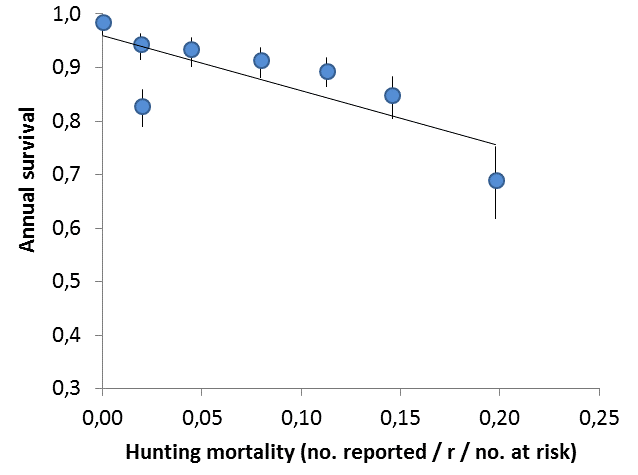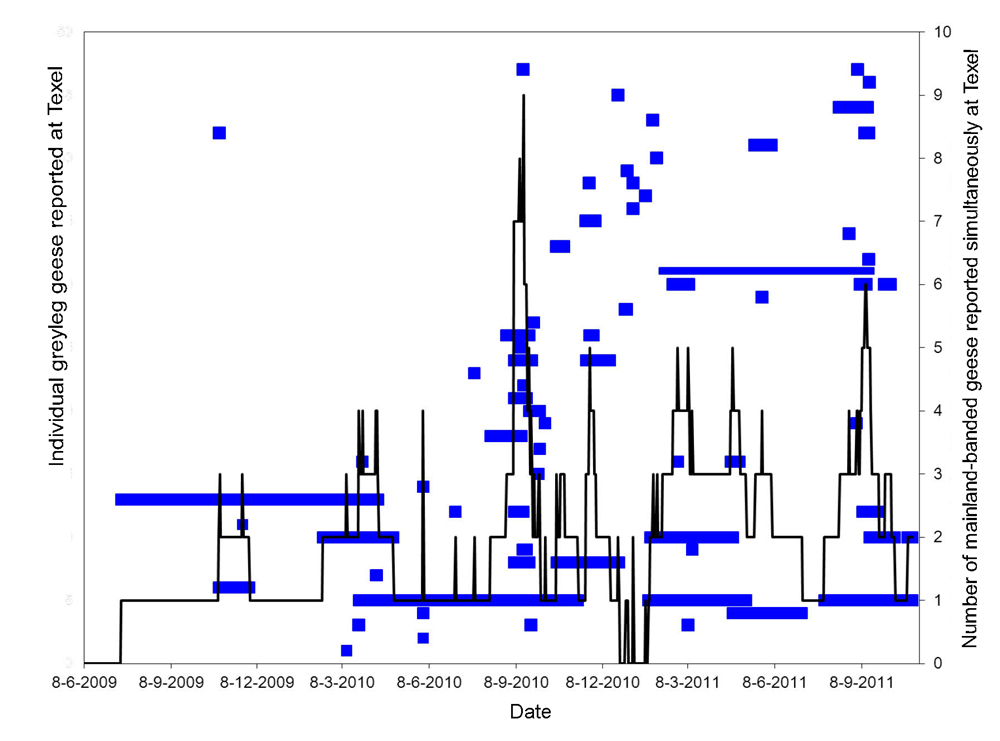To monitor the status of bird populations, in particular geese, just counting birds is not enough. The demographic processes that underlie changes in numbers, particularly reproduction and survival, also need to be monitored. Data on individually marked birds form the basis of these demographic analyses. They enable us to trace the demographical causes of population declines and increases, identify potential threats, and can be used to evaluate the effectiveness of remedial actions to either increase populations of threatened species or reduce populations of species that give rise to human-wildlife conflicts. The data on individually marked geese and swans that are gathered at geese.org are used exactly for these purposes. Below, a number of projects where data gathered at geese.org have been used extensively, are presented.
| Population dynamic parameters of barnacle geese in the Netherlands - NIOO-KNAW / Alterra | |
|
In order to construct a spatial population model for barnacle geese breeding in the Netherlands, population dynamic parameters have been estimated from counts and ringing data in the northern Delta area and some smaller other localities. The data for these analyses were gathered between 2004 and 2010. Analysis of colour-ringing data showed that annual survival of Dutch barnacle geese declined significantly during 2004-2015 from c.95% to 75%, largely due to an increase in hunting pressure introduced to reduce the population and its damage to agricultural crops. A decrease in survival should lead to a decline in numbers in the population, but this was not apparent from the summer counts during the same period. Observations of barnacle geese colour-ringed in the Dutch Delta gathered in Europe showed that natal dispersal was high, and that as much as 30% of birds born in the Delta area setlles elsewhere. A substantial number of male barnacle geese most probably emigrate to the large population that breeds along the shores of the Barents Sea, and the Dutch Barnacle Goose population currently is a source, from which restocking of the Barent’s Sea population takes place. |
 Annual survival of barnacle geese is strongly related to hunting mortality. |
| The importance of geese.org in advancing goose research - Clausen & Madsen, University of Aarhus | |
|
To fully exploit the power of neck collared birds, it is important to clarify both how often the neck collars are lost and also how they might affect the birds carrying them. Thanks to the many observers reporting rings and abdominal profiles of live and dead birds, two recent studies on Pink-footed Geese Anser brachyrhynchus have been able to address these questions. In a recent volume of Bird Study Clausen et al. (2015) analysed the observation history and recovery data from shot and re-captured birds with metal rings, and found that the average annual retention rate of neck collars among Pink-footed Geese was 0.968, cor-responding to an annual loss rate of 3.2%. This figure indicates that collar loss does occur on a regular basis, and that incorporating this effect when analysing e.g. survival is of utmost importance.
|
Pink-footed Goose losing its neck collar. Photo: Dirk Raes |
|
In another study published in Journal of Ornithology, Clausen and Madsen (2014) used the abdominal profile data from www.geese.org to investigate the effect of neckbands on body condition of marked geese. This analysis revealed that geese may experience a transitory decline in body condition just after capture and attachment of the neck collar, but also that there was no long-term effect on the condition of individual geese. This indicates that the capture and handling of the geese may result in short-term impacts on the energetic state of affected individuals, but that the presence of neck collars does not affect condition of birds going forward. The ability to answer these questions, as well as the ongoing task of improving our knowledge of Pink-footed Goose ecology, is completely reliant on committed observers reporting their sighting to www.geese.org, and we are extremely grateful for every contribution adding to the study of these birds.
|
The effect of handling and ringing on the abdominal profile index of Pink-footed Geese |
| Towards adaptive management of white-fronted geese - NIOO-KNAW / Sovon / Radboud University | |
|
White-fronted geese have increased substantially during the last decades and cause damage to agricultural crops. At the same time, the Netherlands are an important wintering area for arctic breeding geese and therefore has an international responsibility for their conservation. What effects are to be expected from hunting and disturbance of white-fronted geese? And to what extent are numbers of white-fronted geese in the Netherlands affected by exchange of birds from wintering populations in other countries? These questions are answered using count data, colour-ring data from geese.org, and data on satellite-tracking of white-fronted geese. We calculated how geese will respond to changes in hunting pressure and disturbance levels, in the Netherlands as well as elsewhere in the Flyway, and how the population might develop under different management scenarios. Exchange between wintering populations of white-fronted geese in the low countries with those in central and eastern Europe occurs, and could be quantified for the first time using all available resightings of colour-marked birds . By changing management options in the model, the optimal balance between reduction of damage to crops and maintaining a healthy population can be found. This project has been carried out for Faunafonds and is a collaboration of Radboud Universiteit Nijmegen, the Netherlands Institute of Ecology (NIOO-KNAW) and Sovon Dutch centre for Field Ornithology, within CAPS. The report will be available here shortly |
|
| Greylag geese dispersal - Alterra/Sovon | |
|
Since the recovery of Greylag Goose (Anser anser) as a breeding bird in the Netherlands, the country’s breeding population is rapidly growing. This is also the case on the island of Texel, where debates regarding greylag geese population management were often heated. However, basic knowledge of the Texel population was lacking. For example, what was the contribution of immigration of mainland geese to growing greylag goose populations on the island? Do mainland geese frequently establish themselves as breeding birds on the island? To answer this question, Kleijn et al. (2012) fitted 364 greylag geese with unique collars on the mainland of Noord-Holland in 2009 and 2010. The re-sightings reported in the www.geese.org database formed the basis for the analysis of spatial dynamics of the Texel breeding population. The study showed that during 2009-2011 Texel was visited by 47 mainland geese, both in winter and in the summer. These geese stayed generally only a short time on the island, with a peak in observations after the breeding season in September. The majority was re-sighted on the mainland after having visited Texel. Most of these were seen outside the breeding season, which suggest that most mainland geese visit Texel mostly to forage. Establishment of breeding greylag geese that had not hatched on the island was not recorded with certainty, although four individuals were present at Texel for extended periods of time including breeding seasons. The authors conclude that breeding dispersion of mainland greylag geese to Texel is uncommon and juvenile dispersion is rather limited. They conclude that mainland-hatched greylag geese contribute little to the growing breeding population on Texel. This project was carried out for Faunafonds and is a collaboration of Alterra WUR and Sovon Dutch centre for Field Ornithology. The full report is available here. |
The presence on the island of Texel of greylag geese colour-banded on the Dutch mainland. The blue bars represent periods during two consecutive observations of the same individuals on Texel. A one-time observation is shown as a dot. The black line indicates the cumulative number of mainland geese reported from the island at any one time.
|


